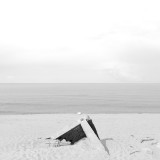Supervisors:
2017
This current research deals with the phenomenon of transformation of the Spiaggia beach, in the prefecture of Ilia, while examining the relationships that develop between the natural and the artificial environment. More specifically, it is a «built» strip along the beach where you can encounter dozens of half-ruined and destroyed by the sea former holiday resorts, which create a unique setting combined with the natural scenery that surrounds them.
The coastal zone of the prefecture of Ilia, mainly from Katakolon and about 20 km southwards is one of the most representative examples of illegal building for the construction of holiday accommodation in Greece, with the arbitrary installation in the region making its own history. This installation began timidly and temporarily. The summer vacationers, local residents, built huts by using cheap materials and with a limited lifetime, which were set up by the beginning of the summer and were restored at the end of the holidays. Gradually though, over the years, the cheap and lightweight materials were replaced by more resistant ones, giving the constructions a more permanent and indestructible, by nature and time, character.
Nevertheless, the life cycle that once characterized the temporary shelters, now features the permanent buildings of the beach. Year in year out, the location of the shoreline is constantly changing and the sea comes to shore, tending to occupy the sandy part of the beach. Many holiday accommodations have been destroyed, whilst many are in danger of extinction in the near future, as nature seems to resist unscrupulous human intervention. The materials that were once considered resistant, are now worn and destroyed, weak to survive the forces of nature.
The view of these «modern ruins» fascinates the traveler of the beach and provokes feelings of awe, while the power of nature against the arbitrary facilities of the tourists and its attempt to return to its original form through its purification from the material interventions lead to a series of questions that attempt to explore the scope of this research.
The research is being conducted alongside two speeds and two observation scales that displace us from the shoreline, to the coast, the beach and the individual shells lying on the sand, with each one of these places emerging different issues for study. The gaze is shifted from the high view, through the use of the satellite, to the experiential view as well as the relationship between them, studying the same condition in two different ways: the prevalence of the natural element against the artificial one, while at the same time dialogues are being developed between art and architecture.
A survey is being carried out on the history of Spiaggia beach and the reasons that led to the seclusion of the beach from loose huts to more permanent constructions, while at the same time there has been an attempt on-site research on the beach, capturing a grid of translocations and referrals, reflections on nature, landscape, the relationships that develop between the natural and the artificial, as long as the reflections on the notion of building, arbitrary building and ruins. The empirical material is offered by the building corpses located in the sand, which create dynamic scenery on the sandy beach of Spiaggia.
